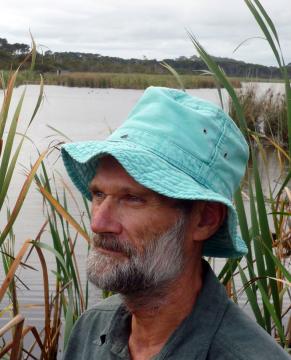Abstract
Mass, solute (chloride), isotope (deuterium) and thermal balances were completed at Perry Lakes, two semi-permanent ‘water table’ lakes near Perth, Western Australia. All balance components except groundwater discharge/recharge were measured independently. These difficult to measure groundwater components of lake-aquifer interaction were estimated by integrating mass, solute and chloride data in sequential 4 day balances spanning two years. Before urbanisation, such wetlands functioned predominantly as flow-through lakes. Now, large winter storm water inputs (and summer artificial level maintenance pumped locally from groundwater) dominate. In East Lake these inputs together comprise 42% of the annual water budget; groundwater discharge is reduced to just 2%. Even under flow-through conditions, these ‘non natural’ inputs are so large East Lake always tends towards a recharge state and commonly becomes a local groundwater mound. Flow-through is established in both lakes over winter. Initially each lake functions separately however as winter progresses shared capture and release zones are established. Maintenance of lake levels in early summer forces East Lake back to recharge status.
Sediment heat flux (Qse) is significant in these very shallow lakes. Over summer Qse was negative, with a net movement of heat from the water into the sediments which act as a seasonal heat sink. In winter Qse was positive and stored summer heat was returned to the water column. This flux at times exceeded 40 W/m². Evaporation was determined independently by floating pan, leaving Qse as the thermal balance residual. Ignoring Qse, annual evaporation determined by thermal balance was over estimated by 7%. Over and under estimates of individual 12 day balance period evaporation exceeded 50%.
Monthly Class A (Perth airport) pan coefficients varied from 0.54 (January) to 0.86 (September). Ten empirical equations for evaporation were calibrated and compared with the East Lake floating pan. Best performer was the Makkink which tracked the floating pan closely throughout all seasons. Poorest were the Penman, DeBruin-Keijman, Priestly-Taylor and Brutsaert-Stricker which grossly over estimated late winter evaporation. Transpiration from Typha orientalis, estimated using hydrograph techniques was 43% of open water evaporation in summer and 28% annually. Temperature controlled evaporation pans (tracking lake temperature) experimentally determined the local deuterium content of lake evaporate δE, required for isotopic balances. Techniques employing pans evaporated to dryness and pans evaporated at constant volume were run in tandem continuously for two years.
This study singularly integrates mass, solute and isotope balances thereby allowing groundwater components to be accurately quantified. The isotope balances are unique, being the only such balances incorporating experimentally derived local deuterium values of lake evaporate. This study represents the only thermal balance, the only accurate determination of pan-lake coefficients and the first calibration of commonly used empirical evaporation equations for Swan Coastal Plain wetlands.
Groundwater levels in the western suburbs of Perth have declined over 40 years and a disproportionate larger decline now seriously threatens Perry Lakes. Modelling suggests regional groundwater extraction exceeds recharge. Wetland managers can no longer maintain East Lake via local groundwater extraction. Artificial recharge using imported surface and waste water are possible future management options.

